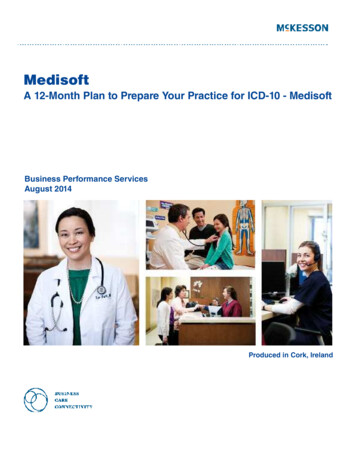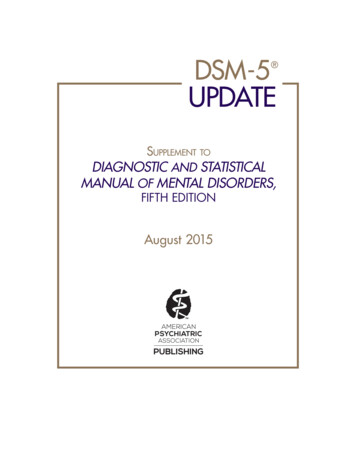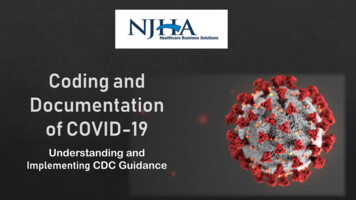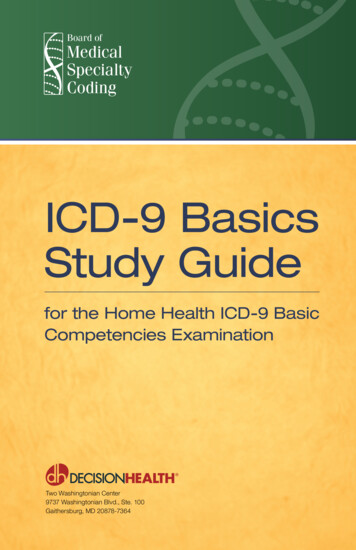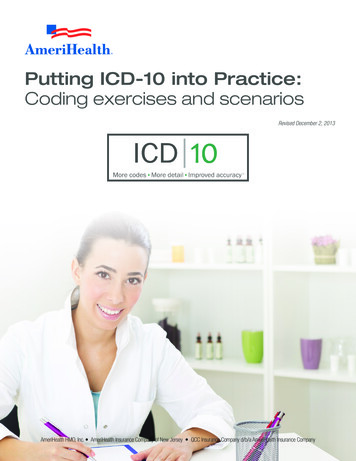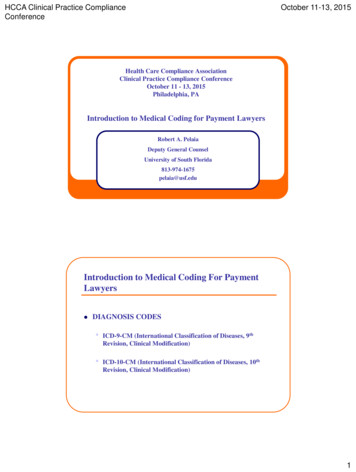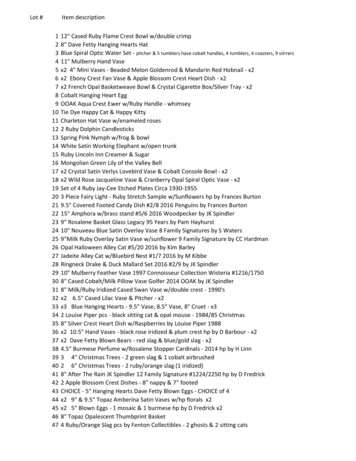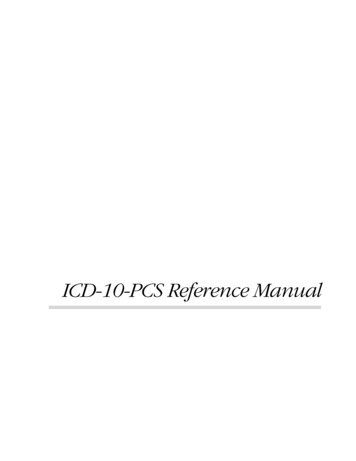
Transcription
Preliminary12/10/07ICD-10-PCS Reference Manual
12/10/07iiICD-10-PCS Reference ManualPreliminary
Preliminary12/10/07THE INTERNATIONAL CLASSIFICATION OF DISEASES TenthRevision Procedure Coding System (ICD-10-PCS) was developedwith the support of the Centers for Medicare and MedicaidServices, under contract Nos. 90-1138, 91-22300, 500-95-0005,and HHSM-500-2004-00011C to 3M Health Information Systems.Rhonda R. Butler, CCS, CCS-PRobert L. Mullin, M.D.Thelma M. Grant, MBA, RHIARichard F. Averill, M.S.Barbara A. Steinbeck, RHITThe opinions expressed are solely those of the authors, and donot necessarily represent those of the Centers for Medicare andMedicaid Services.iii
12/10/07ivICD-10-PCS Reference ManualPreliminary
Preliminary12/10/07PrefaceTHE INTERNATIONAL CLASSIFICATION OF DISEASES TenthRevision Procedure Coding System (ICD-10-PCS) is a new system for coding inpatient procedures, developed for the Centersfor Medicare and Medicaid Services (CMS).This manual is written as a general introduction for data managers, payers, administrators, and medical record coders. Forreaders who do not need a detailed understanding ofICD-10-PCS but would like a general introduction, the materialin chapter 1 and the appendices is recommended.Manual organizationThe manual is organized into the following chapters and appendices. A glossary also provides a list of terms introduced in themanual.Chapter 1Overview. Includes a general introduction to ICD-10-PCS, abrief history of its development, and a presentation of the codestructure, organization, and characteristics. The first part of theoverview contains basic information; the second and third partsdiscuss structure, characteristics, and applications in more detail.Chapter 2Procedures in the Medical and Surgical section. Providesreference material for each root operation in the MEDICAL ANDSURGICAL section (0), with the full definition, additional explanation as needed, a code example, and coding exercises for eachroot operation.Preface v
12/10/07Chapter 3Procedures in the Medical and Surgical-related sections.Provides reference material for each of the Medical andSurgical-related sections (1–9), with definitions, additionalexplanation as needed, a code example, and coding exercisesfor each section.Chapter 4Procedures in the ancillary sections. Provides referencematerial for each of the ancillary sections (B–D, F–H), with definitions, additional explanation as needed, a code example, andcoding exercises for each section.Appendix AICD-10-PCS definitions. Tables listing the full definitions of allroot operations and approaches in the MEDICAL AND SURGICALsection.Appendix BICD-10-PCS draft coding guidelines. Contains draft guidelines for coding procedures with ICD-10-PCS.Conventions usedThis manual uses several conventions throughout, as describedbelow.Small capital lettersSmall capital letters are used to distinguish words that definecode components, as in the root operation TRANSPLANTATION.Root operation boxesDrainage9Character 1SectionRoot operation boxes are used to present the full definition ofroot operations in the MEDICAL AND SURGICAL section, includingexplanation and examples. A root operation box is shownbelow. Root operation boxes are used in chapter 2.DefinitionTaking or letting out fluids and/or gases from a body partExplanationThe fluids or gases may be normal or abnormalExamplesIncision and drainage, thoracentesisTable excerptsviPreliminaryCharacter 2Body SystemTable excerpts present a single code in the ICD-10-PCS Tableformat, identifying all components of the code. Text descriptions are truncated as needed to fit the compressed format, as inthe example below.Character 3Root OperationCharacter 4Body PartCharacter 5ApproachCharacter 6DeviceCharacter 7QualifierMEDICAL ANDSURGICALRESPIRATORYEXCISIONLOWER LOBEBRONCHUS, RTOPENNO DEVICEDIAGNOSTIC0BB60ZXICD-10-PCS Reference Manual
Preliminary12/10/07Root operation groupsThis table is used only in chapter 2 to organize root operationsin the MEDICAL AND SURGICAL section, highlighting distinguishing features.Root operationProcedure ObjectiveProcedure SiteExampleDrainageTaking/letting out fluids/gasesWithin a body partI&D of perinephric cystExtirpationTaking/cutting out solid matterWithin a body partTaking out a kidney stoneFragmentationBreaking solid matter into pieceswithout removalWithin a body partLithotripsy of kidney stonePreface vii
12/10/07viiiICD-10-PCS Reference ManualPreliminary
Preliminary12/10/07ContentsChapter 1ICD-10-PCS overviewWhat is ICD-10-PCS?1.31.4History of ICD-10-PCS 1.4ICD-9-CM Volume 3 compared with ICD-10-PCSICD-10-PCS code structureCharacters 1.6Values 1.61.41.6Code structure: Medical and Surgical sectionCharacter 1: Section 1.7Character 2: Body system 1.7Character 3: Root operation 1.8Character 4: Body part 1.8Character 5: Approach 1.8Character 6: Device 1.9Character 7: Qualifier 1.91.7ICD-10-PCS system organization 1.11Medical and Surgical section 1.11Medical and Surgical-related sectionsAncillary sections 1.12Tables 1.13Index 1.15List of Codes 1.17ICD-10-PCS design1.111.18Multiaxial structure 1.18Completeness 1.19Expandability 1.21Contents ix
12/10/07PreliminaryICD-10-PCS additional characteristics 1.23Standardized terminology 1.23Standardized level of specificity 1.24Diagnosis information excluded 1.25NOS code options restricted 1.25Limited NEC code options 1.25ICD-10-PCS applications1.26Optimal search capability 1.26Consistent characters and valuesCode readability 1.28Chapter 21.27Procedures in the Medical and Surgical sectionRoot operation groups2.52.6Root operations that take out some or all of a body part2.8Excision—Root operation B 2.9Resection—Root operation T 2.11Detachment—Root operation 6 2.13Destruction—Root operation 5 2.16Extraction—Root operation D 2.18Root operations that take out solids/fluids/gases from a bodypart 2.20Drainage—Root operation 9 2.21Extirpation—Root operation C 2.23Fragmentation—Root operation F 2.25Root operations involving cutting or separation onlyDivision—Root operation 8 2.28Release—Root operation N 2.292.27Root operations that put in/put back or move some/all of a bodypart 2.31Transplantation—Root operation Y 2.32Reattachment—Root operation M 2.34Transfer—Root operation X 2.36Reposition—Root operation S 2.38Root operations that alter the diameter/route of a tubular bodypart 2.40Restriction—Root operation V 2.41Occlusion—Root operation L 2.43Dilation—Root operation 7 2.45Bypass—Root operation 1 2.47Root operations that always involve a deviceInsertion—Root operation H 2.50Replacement—Root operation R 2.52Change—Root operation 2 2.54x ICD-10-PCS Reference Manual2.49
Preliminary12/10/07Removal—Root operation P 2.55Revision—Root operation W 2.57Root operations involving examination only2.58Inspection—Root operation J 2.59Map—Root operation K 2.60Root operations that define other repairs2.622.632.61Control—Root operation 3Repair—Root operation QRoot operations that define other objectives2.65Fusion—Root operation G 2.66Alteration—Root operation 0 2.68Creation—Root operation 4 2.70Chapter 3Procedures in the Medical and Surgical-relatedsections 3.3List of Medical and Surgical-related sections of ICD-10-PCS3.4Obstetrics—Section 1 3.5Root operations 3.5Placement—Section 2 3.7Root operations 3.7Administration—Section 3 3.10Root operations 3.10Measurement and Monitoring—Section 4Root operations 3.123.12Extracorporeal Assistance and Performance—Section 5Root operations 3.14Extracorporeal Therapies—Section 6Root operations 3.16Osteopathic—Section 7Chapter 43.163.19Other Procedures—Section 8Chiropractic—Section 93.203.22Procedures in the ancillary sectionsList of ancillary sections in ICD-10-PCSImaging—Section BRoot types 4.53.144.34.44.5Contents xi
12/10/07Nuclear Medicine—Section CRoot types 4.8Preliminary4.8Radiation Oncology—Section DRoot type 4.114.11Physical Rehabilitation and Diagnostic Audiology—Section FRoot types 4.13Mental Health—Section GRoot Type 4.174.17Substance Abuse Treatment—Section HRoot Types 4.19Appendix AICD-10-PCS definitions A.3Root operationsApproachesAppendix B4.19A.4A.8ICD-10-PCS draft coding guidelines B.3A. General B.3B. Medical and Surgical section (section 0) B.4Body system guidelines B.4Root operation guidelines B.4Body part guidelines B.7Approach guidelines B.9Device guidelines B.10C. Other medical and surgical-related sections (sections 1–9)IndexxiiICD-10-PCS Reference ManualAlphabetical index I.1B.114.13
TablesTable1–11–21–3Title and pageComparison of ICD-9-CM and ICD-10-PCS 1.5Introductory table of values for the Medical and Surgical section Urinary body system (characters 3–7) 1.14Comparison of CABG procedure codes 1.20Tablesxiii
xiv ICD-10-PCS Reference Manual
Preliminary12/10/07Chapter 1ICD-10-PCS overview1
12/10/07ContentsICD-10-PCS overviewWhat is ICD-10-PCS?Preliminary1.31.4History of ICD-10-PCS 1.4ICD-9-CM Volume 3 compared with ICD-10-PCSICD-10-PCS code structureCharacters 1.6Values 1.61.6Code structure: Medical and Surgical sectionCharacter 1: Section 1.7Character 2: Body system 1.7Character 3: Root operation 1.8Character 4: Body part 1.8Character 5: Approach 1.8Character 6: Device 1.9Character 7: Qualifier 1.9ICD-10-PCS system organization 1.11Medical and Surgical section 1.11Medical and Surgical-related sectionsAncillary sections 1.12Tables 1.13Index 1.15List of Codes 1.17ICD-10-PCS design1.111.18Multiaxial structure 1.18Completeness 1.19Expandability 1.21ICD-10-PCS additional characteristics 1.23Standardized terminology 1.23Standardized level of specificity 1.24Diagnosis information excluded 1.25NOS code options restricted 1.25Limited NEC code options 1.25ICD-10-PCS applications1.26Optimal search capability 1.26Consistent characters and valuesCode readability 1.281.2ICD-10-PCS Reference Manual1.271.71.4
Preliminary12/10/07Chapter 1ICD-10-PCS overviewTHE INTERNATIONAL CLASSIFICATION OF DISEASES TenthRevision Procedure Coding System (ICD-10-PCS) was created toaccompany the World Health Organization’s (WHO) ICD-10diagnosis classification. The new procedure coding system wasdeveloped to replace ICD-9-CM procedure codes for reportinginpatient procedures.Unlike the ICD-9-CM classification, ICD-10-PCS was designed toenable each code to have a standard structure and be verydescriptive, and yet flexible enough to accommodate futureneeds. Information about the structure, organization, and application of ICD-10-PCS codes, along with reference material forcoding with ICD-10-PCS, is provided in this manual.This chapter contains the following parts: What is ICD-10-PCS?ICD-10-PCS code structureICD-10-PCS system organizationICD-10-PCS designICD-10-PCS additional characteristicsICD-10-PCS applicationsMore specific information on coding with ICD-10-PCS is foundin chapters 2–4 of this manual.ICD-10-PCS overview 1.3
12/10/07PreliminaryWhat is ICD-10-PCS?ICD-10-PCS is a procedure coding system that will be used tocollect data, determine payment, and support the electronichealth record for all inpatient procedures performed in theUnited States.History of ICD-10-PCSThe World Health Organization has maintained the InternationalClassification of Diseases (ICD) for recording cause of deathsince 1893. It has updated the ICD periodically to reflect newdiscoveries in epidemiology and changes in medical understanding of disease.The International Classification of Diseases Tenth Revision(ICD-10), published in 1992, is the latest revision of the ICD. TheWHO authorized the National Center for Health Statistics (NCHS)to develop a clinical modification of ICD-10 for use in the UnitedStates. This version of ICD-10 is called ICD-10-CM. ICD-10-CM isintended to replace the previous U.S. clinical modification,ICD-9-CM, that has been in use since 1979. ICD-9-CM contains aprocedure classification; ICD-10-CM does not.The Centers for Medicare and Medicaid Services, the agencyresponsible for maintaining the inpatient procedure code set inthe U.S., contracted with 3M Health Information Systems in 1993to design and then develop a procedure classification system toreplace Volume 3 of ICD-9-CM. ICD-10-PCS is the result.ICD-10-PCS was initially released in 1998. It has been updatedannually since that time.ICD-9-CM Volume 3 comparedwith ICD-10-PCSWith ICD-10 implementation, the U.S. clinical modification of theICD will not include a procedure classification based on thesame principles of organization as the diagnosis classification.Instead, a separate procedure coding system has been developed to meet the rigorous and varied demands that are made ofcoded data in the healthcare industry. This represents a significant step toward building a health information infrastructure thatfunctions optimally in the electronic age.The following table highlights basic differences betweenICD-9-CM Volume 3 and ICD-10-PCS.1.4ICD-10-PCS Reference Manual
Preliminary12/10/07Table 1–1.What is ICD-10-PCS?Comparison of ICD-9-CM and ICD-10-PCSICD-9-CM Volume 3ICD-10-PCSFollows ICD structure (designedfor diagnosis coding)Designed/developed to meet healthcareneeds for a procedure code systemCodes available as a fixed/finiteset in list formCodes constructed from flexible codecomponents (values) using tablesCodes are numericCodes are alphanumericCodes are 3–4 digits longAll codes are seven characters longICD-10-PCS overview 1.5
Preliminary12/10/07ICD-10-PCS code structureUndergirding ICD-10-PCS is a logical, consistent structure thatinforms the system as a whole, down to the level of a singlecode. This means that the process of constructing codes inICD-10-PCS is also logical and consistent: individual letters andnumbers, called “values,” are selected in sequence to occupythe seven spaces of the code, called “characters.”CharactersAll codes in ICD-10-PCS are seven characters long. Each characterin the seven-character code represents an aspect of the procedure, as shown in the following diagram of characters from themain section of ICD-10-PCS, called MEDICAL AND SURGICAL.SectionCharacters:1Root operation2Body system34Body partApproach5Qualifier67DeviceAn ICD-10-PCS code is best understood as the result of a processrather than as an isolated, fixed quantity. The process consists ofassigning values from among the valid choices for that part of thesystem, according to the rules governing the construction ofcodes.ValuesOne of 34 possible values can be assigned to each character ina code: the numbers 0–9 and the alphabet (except I and O,because they are easily confused with the numbers 1 and 0). Afinished code looks like the example below.02100Z4This code is derived by choosing a specific value for each of theseven characters. Based on details about the procedure performed, values for each character specifying the section, bodysystem, root operation, body part, approach, device, and qualifier are assigned.Because the definition of each character is a function of itsphysical position in the code, the same value placed in a differ-1.6ICD-10-PCS Reference Manual
Preliminary12/10/07ICD-10-PCS code structureent position in the code means something different. The value 0in the first character means something different than 0 in thesecond character, or 0 in the third character, and so on.Code structure: Medical andSurgical sectionCharacter 1: SectionThe following pages define each character using the code0LB50ZZ, “Excision of right lower arm and wrist tendon, openapproach” as an example. This example comes from the MEDICALAND SURGICAL section of ICD-10-PCS.The first character in the code determines the broad procedurecategory, or section, where the code is found. In this example,the section is MEDICAL AND SURGICAL. 0 is the value that represents MEDICAL AND SURGICAL in the first character.For definitions of characters used in the Medical and Surgicalsection, please refer to the Glossary.The sample code looks like this so far:Character 1SectionCharacter 2Body SystemCharacter 3Root OperationCharacter 4Body PartCharacter 5ApproachCharacter 6DeviceCharacter 7QualifierMEDICAL ANDSURGICAL0Character 2: Body systemCharacter 1SectionCharacter 2Body SystemMEDICAL ANDSURGICALTENDONS0LThe second character defines the body system—the generalphysiological system or anatomical region involved. Examplesof body systems include LOWER ARTERIES, CENTRAL NERVOUSSYSTEM, and RESPIRATORY SYSTEM. In this example, the bodysystem is TENDONS, represented by the value L.Character 3Root OperationCharacter 4Body PartCharacter 5ApproachCharacter 6DeviceCharacter 7QualifierICD-10-PCS overview 1.7
ICD-10-PCS code structure12/10/07Character 3: Root operationCharacter 1SectionCharacter 2Body SystemPreliminaryThe third character defines the root operation, or the objectiveof the procedure. Some examples of root operations are BYPASS,DRAINAGE, and REATTACHMENT. In the sample code below, theroot operation is EXCISION. When used in the third character ofthe code, the value B represents EXCISION.Character 3Root OperationMEDICAL ANDSURGICALTENDONSEXCISION0LBCharacter 4Body PartCharacter 5ApproachCharacter 6DeviceCharacter 7QualifierFor the complete list of root operations and their definitions,please refer to appendix A.Character 4: Body partThe fourth character defines the body part, or specific anatomical site where the procedure was performed. The body system(second character) provides only a general indication of theprocedure site. The the body part and body system valuestogether provide a precise description of the procedure site.Examples of body parts are KIDNEY, TONSILS, and THYMUS. In thisexample, the body part value is 5, LOWER ARM AND WRIST, RIGHT.When the second character is L, the value 5 when used in thefourth character of the code represents the right lower arm andwrist tendon.Character 1SectionCharacter 2Body SystemCharacter 3Root OperationCharacter 4Body PartMEDICAL ANDSURGICALTENDONSEXCISIONLOWER ARM ANDWRIST, RIGHT0LB5Character 5: ApproachCharacter 5ApproachCharacter 6DeviceCharacter 7QualifierThe fifth character defines the approach, or the technique usedto reach the procedure site. Eight different approach values areused in the MEDICAL AND SURGICAL section to define theapproach. Examples of approaches include OPEN andPERCUTANEOUS ENDOSCOPIC.In the sample code below, the approach is OPEN and isrepresented by the value 0.1.8ICD-10-PCS Reference Manual
Preliminary12/10/07Character 1SectionCharacter 3Root OperationCharacter 2Body SystemICD-10-PCS code structureCharacter 4Body PartCharacter 5ApproachMEDICAL ANDSURGICALTENDONSEXCISIONLOWER ARM ANDWRIST, RIGHTOPEN0LB50Character 6DeviceCharacter 7QualifierFor the complete list of approaches and their definitions, pleaserefer to appendix A.Character 6: DeviceDepending on the procedure performed, there may or may notbe a device left in place at the end of the procedure. The sixthcharacter defines the device. Device values fall into four basiccategories: Grafts and ProsthesesImplantsSimple or Mechanical AppliancesElectronic AppliancesIn this example, there is no device used in the procedure. Thevalue Z is used to represent NO DEVICE, as shown below.Character 1SectionCharacter 2Body SystemCharacter 3Root OperationCharacter 4Body PartCharacter 5ApproachCharacter 6DeviceMEDICAL ANDSURGICALTENDONSEXCISIONLOWER ARM ANDWRIST, RIGHTOPENNO DEVICE0LB50ZCharacter 7: QualifierCharacter 7QualifierThe seventh character defines a qualifier for the code. A qualifier specifies an additional attribute of the procedure, ifapplicable.Examples of qualifiers include DIAGNOSTIC and STEREOTACTIC.Qualifier choices vary depending on the previous valuesselected. In this example, there is no specific qualifier applicable to this procedure, so the value is NO QUALIFIER, representedby the letter Z.ICD-10-PCS overview 1.9
ICD-10-PCS code structureCharacter 1SectionCharacter 2Body System12/10/07Character 3Root OperationCharacter 4Body PartCharacter 5ApproachPreliminaryCharacter 6DeviceCharacter 7QualifierMEDICAL ANDSURGICALTENDONSEXCISIONLOWER ARM ANDWRIST, RIGHTOPENNO DEVICENO QUALIFIER0LB50ZZ0LB50ZZ is the complete specification of the procedure“Excision of right lower arm and wrist tendon, open approach.”1.10ICD-10-PCS Reference Manual
Preliminary12/10/07ICD-10-PCS system organizationICD-10-PCS is composed of 16 sections, represented by thenumbers 0–9 and the letters B–D and F–H. The broad procedure categories contained in these sections range from surgicalprocedures to substance abuse treatment.Medical and Surgical sectionCharacter 1SectionCharacter 2Body SystemThe first section, MEDICAL AND SURGICAL, contains the greatmajority of procedures typically reported in an inpatient setting.As shown in the previous section discussing ICD-10-PCS codestructure, all procedure codes in the MEDICAL AND SURGICALsection begin with the section value 0.Character 3Root OperationCharacter 4Body PartCharacter 5ApproachCharacter 6DeviceCharacter 7QualifierMEDICAL ANDSURGICALTENDONSEXCISIONLOWER ARM ANDWRIST, RIGHTOPENNO DEVICENO QUALIFIER0LB50ZZMore complete information on coding procedures in the Medical and Surgical section is found in chapter 2 of this manual.Medical and Surgical-relatedsectionsSections 1–9 of ICD-10-PCS comprise the Medical and Surgical-related sections. These sections include obstetricalprocedures, administration of substances, measurement andmonitoring of body functions, and extracorporeal therapies, aslisted in the table below.Section on4Measurement and Monitoring5Extracorporeal Assistance and Performance6Extracorporeal Therapies7Osteopathic8Other Procedures9ChiropracticICD-10-PCS overview 1.11
ICD-10-PCS system organization12/10/07PreliminaryIn sections 1 and 2, all seven characters define the same aspectsof the procedure as in the MEDICAL AND SURGICAL section.Codes in sections 3–9 are structured for the most part like theircounterparts in the MEDICAL AND SURGICAL section, with a fewexceptions. For example, in sections 5 and 6, the fifth characteris defined as duration instead of approach, as in this code forintra-aortic balloon pump (IABP):Character 1SectionCharacter 2Body SystemEXTRACORP. PHYSIOLOGICALASSIST. ANDSYSTEMSPERFORMANCE5Character 3Root OperationCharacter 4Body SystemASSISTANCECARDIACCONTINUOUSOUTPUTBALLOON PUMP02210ACharacter 5DurationCharacter 6FunctionCharacter 7QualifierAdditional differences include these uses of the sixth character: Section 3 defines the sixth character as substance. Sections 4 and 5 define the sixth character as function. Sections 7–9 define the sixth character as method.More complete information on coding procedures in the Medicaland Surgical-related sections is found in chapter 3 of this manual.Ancillary sectionsSections B–D and F–H comprise the ancillary sections ofICD-10-PCS. These six sections include imaging procedures,nuclear medicine, and substance abuse treatment, as listed inthe following table.Section valueDescriptionBImagingCNuclear MedicineDRadiation OncologyFPhysical Rehabilitation and Diagnostic AudiologyGMental HealthHSubstance Abuse TreatmentThe definitions of some characters in the ancillary sections differs from that seen in previous sections. In the IMAGING section,the third character is defined as type, and the fifth and sixthcharacters define contrast and contrast/qualifier respectively, asin the CT scan example below.1.12ICD-10-PCS Reference Manual
Preliminary12/10/07Character 1SectionCharacter 3TypeIMAGINGBCharacter 2Body SystemICD-10-PCS system organizationCharacter 4Body aracter 5ContrastHIGH OSMOLARCharacter 6QualifierCharacter 7QualifierUNENHANCEDENHANCEDNONE0ZAND0Additional differences include: Section C defines the fifth character as radionuclide. Section D defines the fifth character as modality qualifierand the sixth character as isotope. Section F defines the tdefines the fifth character as typequalifier and the sixth character as equipment. Sections G and H define the third character as a typequalifier.More complete information on coding procedures in theancillary sections is found in chapter 4 of this manual.TablesThe complete ICD-10-PCS is presented in three parts: theTables, the Index, and the List of Codes.The Tables are organized in a series, beginning with section 0,MEDICAL AND SURGICAL, and body system 0, CENTRAL NERVOUS,and proceeding in numerical order. Sections 0–9 are followedby sections B–D and F–H. The same convention is followedwithin each table for the second through the seventh characters—numeric values in order first, followed by alphabeticalvalues in order.The following examples use the MEDICAL AND SURGICAL section todescribe the organization and format of the ICD-10-PCS Tables.The MEDICAL AND SURGICAL section (first character 0) is organized by its 31 body system values. Each body systemsubdivision in theMEDICAL AND SURGICAL section contains an introductory tablethat lists the possible values for the remaining characters, giventhat body system.The following example shows the introductory table for theURINARY system.ICD-10-PCS overview 1.13
ICD-10-PCS system organizationTable 1–2.12/10/07PreliminaryIntroductory table of values for the Medical and Surgical section Urinary body system (characters 3–7)OperationCharacter 3Body PartCharacter 4ApproachCharacter 5DeviceCharacter 6QualifierCharacter 71 Bypass0 Kidney, Right0 Open0 Drainage Device0 Allogeneic2 Change1 Kidney, Left2 Open Endoscopic1 RadioactiveElement1 Syngeneic5 Destruction2 Kidneys, Bilateral3 Percutaneous2 MonitoringDevice2 Zooplastic7 Dilation3 Kidney Pelvis, Right4 PercutaneousEndoscopic3 Infusion Device3 Kidney Pelvis,Right8 Division4 Kidney Pelvis, Left7 Via Natural or ArtificialOpening7 AutologousTissue Substitute4 Kidney Pelvis,Left9 Drainage5 Kidney8 Via Natural or ArtificialOpening EndoscopicC ExtraluminalDevice6 Ureter, RightB Excision6 Ureter, RightX ExternalD IntraluminalDevice7 Ureter, LeftC Extirpation7 Ureter, LeftJ SyntheticSubstitute8 ColonF Fragmentation8 Ureters, BilateralK NonautologousTissue Substitute9 ColocutaneousH Insertion9 UreterL ArtificialSphincterA IleumJ InspectionB BladderM ElectrodeB BladderL OcclusionC Bladder NeckY Other DeviceC IleocutaneousM ReattachmentD UrethraZ No DeviceD CutaneousN ReleaseX DiagnosticP RemovalZ No QualifierQ RepairR ReplacementS RepositionT ResectionV RestrictionW RevisionY TransplantationFollowing the introductory table are the root operation tables.These tables provide the valid choices of values available toconstruct a code.1.14ICD-10-PCS Reference Manual
Preliminary12/10/07ICD-10-PCS system organizationThe root operation tables consist of four columns and a varyingnumber of rows, as in the following example of the root operation BYPASS, in the CENTRAL NERVOUS body system.SectionBody systemRoot operation0: MEDICAL AND SURGICAL0: CENTRAL NERVOUS1: BYPASS: Altering the route of passage of the contents of a tubular body partBody PartCharacter 4ApproachCharacter 5DeviceCharacter 6QualifierCharacter 76 Cerebral Ventricle0 Open7 Autologous TissueSubstituteJ Synthetic SubstituteK Nonautologous TissueSubstitute012345678BNasopharynxMastoid SinusAtriumBlood VesselPleural CavityIntestinePeritoneal CavityUrinary TractBone MarrowCerebral CisternsU Spinal Canal0 Open7 Autologous TissueSubstituteJ Synthetic SubstituteK Nonautologous TissueSubstitute4679Pleural CavityPeritoneal CavityUrinary TractFallopian TubeThe values for characters 1–3 are provided at the top of eachtable. Four columns contain the applicable values for characters 4–7, given the values in characters 1–3.A table may be separated into rows to specify the valid choicesof values in characters 4–7. A built using values from more thanone row of a table is not a valid code.For the complete list of ICD-10-PCS draft coding guidelines,please refer to appendix B.IndexThe ICD-10-PCS Index can be used to access the Tables. TheIndex mirrors the structure of the Tables, so it follows a consistent pattern of organization and use of hierarchies.The Index is organized as an alphabetic lookup. Two types ofmain terms are listed in the Index: Based on the value of the third characterCommon procedure termsICD-10-PCS overview 1.15
ICD-10-PCS system organizationMain terms12/10/07PreliminaryFor the MEDICAL AND SURGICAL and related sections, the rootoperation values are used as main terms in the Index. In othersections, the values representing the general type of procedureperformed, such as nuclear medicine or imaging type, are listedas main terms.For the MEDICAL AND SURGICAL and related sections, values suchas EXCISION, BYPASS, and TRANSPLANTATION are included as mainterms in the Index. The applicable body system entries arelisted beneath the main term, and refer to a specific table. Forthe ancillary sections, values such as FLUOROSCOPY andPOSITRON EMISSION TOMOGRAPHY are listed as main terms.In the example below, the index entry “Bypass” refers to theMEDICAL AND SURGICAL section tables for all applicable body systems, including ANATOMICAL REGIONS and CENTRAL NERVOUSSYSTEM.Bypassby Body SystemAnatomical Regions 0W1.Central Nervous System 001.The body system listings may be followed by entries for specificbody parts, as in the excerpt below. In the root operationsCHANGE, INSERTION, REMOVAL, and REVISION, the device entriesfollow the body system listings.by Body PartArteryAorta, Abdominal 0410.Aorta, Thoracic 021W.Axillary 031.Brachial 031.Common Carotid 031.Common procedure termsThe second type of term listed in the Index uses procedurenames, such as “appendectomy” or “fundoplication.” Theseentries are listed as main terms, and refer to a table or tablesfrom which a valid code can be constructed, as shown in thefollowing example.Cholecystectomy– see Excision, Hepatobiliary System & Pancreas 0FB.– see Resection, Hepatobiliary System & Pancreas 0FT.1.16ICD-10-PCS Reference Manual
Preliminary12/10/07List of CodesICD-10-PCS sy
x ICD-10-PCS Reference Manual 12/10/07 Preliminary ICD-10-PCS additional characteristics 1.23 Standardized terminology 1.23 Standardized level of specificity 1.24 Diagnosis information excluded 1.25 NOS code options restricted 1.25 Limited NEC code options 1.25 ICD-10-PCS applications 1.26 Optimal search cap
